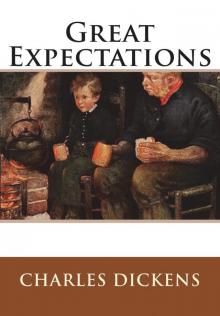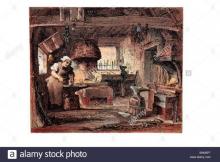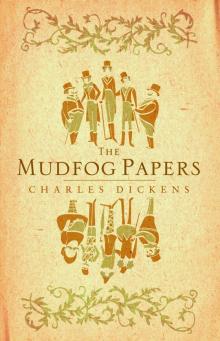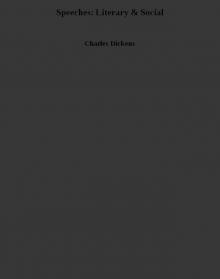- Home
- Charles Dickens
The Mudfog Papers Page 12
The Mudfog Papers Read online
Page 12
This conflict in Dickens’s personal affairs also had an effect on his professional life: in 1859 the author fell out with Bradbury and Evans after they had refused to run another statement about his private life in one of their publications, the satirical magazine Punch. This led him to transfer back to Chapman and Hall and to found a new weekly periodical All the Year Round. His first contribution to the magazine was his highly successful second historical novel, A Tale of Two Cities (1859), an un-Dickensian work in that it was more or less devoid of comical and satirical elements. All the Year Round – which focused more on fiction and less on journalistic pieces than its predecessor – maintained very healthy circulation figures, especially as the second novel to be serialized was the tremendously popular The Woman in White by Wilkie Collins, who became a regular collaborator. Dickens also arranged with the New York publisher J.M. Emerson & Co. for his journal to appear across the Atlantic. In December 1860, Dickens began to serialize what would become one of his best-loved novels, the deeply autobiographical Great Expectations (1860–61).
Between the final instalment of Great Expectations and the first instalment of his next and final completed novel, Our Mutual Friend, there was an uncharacteristically long three-year gap. This period was marked by two deaths in the family in 1863: that of his mother – which came as a relief more than anything, as she had been declining into senility for some time, and Dickens’s feeling for her were ambivalent at best – and that of his second son, Walter – for whom Dickens grieved much more deeply. He chewed over ideas for Our Mutual Friend for at least two years and only began seriously composing it in early 1864, with serialization beginning in May. Although the book is now widely considered a masterpiece, it met with a tepid reception at the time, as readers did not entirely understand it.
On 9th June 1865, Dickens experienced a traumatic incident: travelling back from France with Ellen Ternan and her mother, he was involved in a serious railway accident at Staplehurst, in which ten people lost their lives. Dickens was physically unharmed, but nevertheless profoundly affected by it, having spent hours tending the dying and injured with brandy. He drew on the experience in the writing of one of his best short stories, ‘The Signalman’.
Following the success of his public readings in Britain, Dickens had been contemplating a tour of the United States, and finally embarked on a second trip to America from December 1867 to April 1868. This turned out to be a very lucrative visit, but the exhaustion occasioned by his punishing schedule proved to be disastrous for his health. He began a farewell tour around England in 1868, incorporating a spectacular piece derived from Oliver Twist’s scene of Nancy’s murder, but was forced to abandon the tour on the instructions of his doctors after he had a stroke in April 1869. Against medical advice, he insisted on giving a series of twelve final readings in London in 1870. These were very well received, many of those who attended commenting that he had never read so well as then. While in London, he had a private audience with Queen Victoria, and met the Prime Minister.
Dickens immersed himself in writing another major novel, The Mystery of Edwin Drood, the first six instalments of which were a critical and financial success. Tragically this novel was never to be completed, as Dickens died on 9th June 1870, having suffered a stroke on the previous day. He had wished to be buried in a small graveyard in Rochester, but this was overridden by a nationwide demand that he should be laid to rest in Westminster Abbey. This was done on 14th June 1870, after a strictly private ceremony which he had insisted on in his will.
Charles Dickens’s Works
As seen in the account of his life above, Charles Dickens was an immensely prolific writer, not only of novels but of countless articles, sketches, occasional writings and travel accounts, published in newspapers, magazines and in volume form. Descriptions of his most famous works can be found below.
Sketches by Boz, a revised and expanded collection of Dickens’s newspaper pieces, was published in two volumes by John Macrone on 8th February 1836. The book was composed of sketches of London life, manners and society. It was an immediate success, and was praised by critics for the “startling fidelity” of its descriptions.
The first instalment of Dickens’s first serialized novel, The Pickwick Papers, appeared in March 1836. Initially Dickens’s contributions were subordinate to those of the illustrator Robert Seymour, but as the series continued, this relationship was inverted, with Dickens’s writing at the helm. This led to an upsurge in sales, until The Pickwick Papers became a fully fledged literary phenomenon, with circulation rocketing to 40,000 by the final instalment in November 1837. The book centres around the Pickwick Club and its founder, Mr Pickwick, who travels around the country with his companions Mr Winkle, Mr Snodgrass and Mr Tupman, and consists of various loosely connected and light-hearted adventures, with hints of the social satire which would pervade his mature fiction. There is no overall plot, as Dickens invented one episode at a time and, reacting to popular feedback, would switch the emphasis to the most successful characters.
Dickens’s first coherently structured novel, Oliver Twist, was serialized in Bentley’s Miscellany from February 1837 to April 1839, with illustrations by the famous caricaturist George Cruikshank. Subtitled A Parish Boy’s Progress, in reference to Hogarth’s A Rake’s Progress and A Harlot’s Progress cycles, Dickens tells the story of a young orphan’s life and ordeals in London – which had never before been the substance of a novel – as he flees the workhouse and unhappy apprenticeship of his childhood to London, where he falls in with a criminal gang led by the malicious Fagin, before eventually discovering the secret of his origins. Oliver Twist publicly addressed issues such as workhouses and child exploitation by criminals – and this preoccupation with social ills and the plight of the downtrodden would become a hallmark of Dickens’s fiction.
Dickens’s next published novel – the serialization of which for a while overlapped with that of Oliver Twist – was Nicholas Nickleby, which revolves around its eponymous hero – again an impoverished young man, though an older one this time – as he tenaciously overcomes the odds to establish himself in the world. When Nicholas’s father dies penniless, the family turn to their uncle Ralph Nickleby for assistance, but he turns out to be a mean-spirited miser, and only secures menial positions for Nicholas and his sister Kate. Nicholas is sent to work in Dotheboys Hall, a dreadful Yorkshire boarding school administered by the schoolmaster Wackford Squeers, while Kate endures a humiliating stint at a London millinery. The plot twists and turns until both end up finding love and a secure position in life. Dickens’s satire is more trenchant, particularly with regard to Yorkshire boarding schools, which were notorious at the time. Interestingly, within ten years of Nicholas Nickleby’s publication all the schools in question were closed down. Overall though, the tone is jovial and the plot is rambling and entertaining, much in the vein of Dickens’s eighteenth-century idols Fielding and Smollett.
The Old Curiosity Shop started out as a piece in the short-lived weekly magazine that Dickens was editing, Master Humphrey’s Clock, which began publication in April 1840. It was intended to be a miscellany of one-off stories, but as sales were disappointing, Dickens was forced to adapt the ‘Personal Adventures of Master Humphrey’ into a full-length narrative that would be the most Romantic and fairy-tale-like of Dickens’s novels, with some of his greatest humorous passages. The story revolves around Little Nell, a young girl who lives with her grandfather in his eponymous shop, and recounts how the two struggle to release themselves from the grip of the evil usurer dwarf Quilp. By the end of its serialization, circulation had reached the phenomenal figure of 100,000, and Little Nell’s death had famously plunged thousands of readers into grief.
As seen above, Dickens took on a different genre for his next major work of fiction, Barnaby Rudge: this was a historical novel, addressing the anti-Catholic Gordon riots of 1780, which focused on a village outside London and its protagonist, a simple
ton called Barnaby Rudge. The novel was serialized in Master Humphrey’s Clock from 1840 to 1841, and met with a lukewarm reception from the reading public, who thirsted for more novels in the vein of The Old Curiosity Shop.
Dickens therefore gave up on the historical genre, and began serializing the more picaresque Martin Chuzzlewit from December 1842 to June 1844. The book explores selfishness and its consequences: the eponymous protagonist is the grandson and heir of the wealthy Martin Chuzzlewit senior, and is surrounded by relatives eager to inherit his money. But when Chuzzlewit junior finds himself disinherited and penniless, he has to make his own way in the world. Although it was a step forwards in his writing, being the first of his works to be written with a fully predetermined overall design, it sold poorly – partly due to the fact that publishing in general was experiencing a slump in the early 1840s. In a bid to revive sales, Dickens adjusted the plot during the serialization and sent the title character to America – his own recent visit there providing much material.
In 1843, Dickens had the idea of writing a small seasonal Christmas book, which would aim to revive the spirit of the holiday and address the social problems that he was increasingly interested in. The resulting work, A Christmas Carol, was a phenomenal success at the time, and the tale and its characters, such as Scrooge, Bob Cratchit and Tiny Tim, have now achieved an iconic status. Thackeray famously praised it as “a national benefit and to every man or woman who reads it a personal kindness”. Dickens published four more annual Christmas novellas – The Chimes, The Cricket on the Hearth, The Battle of Life and The Haunted Man – which were successful at the time, but did not quite live up to the classic appeal of A Christmas Carol. After The Haunted Man, Dickens discontinued his Christmas books, but he included annual Christmas stories in his magazines Household Words and All the Year Round. Each set of these stories usually took the form of a miniature Arabian Nights, with a number of unrelated short stories linked together through a frame narrative – typically Dickens wrote the frame narrative, and invited other writers to supply the stories included within it, writing the occasional one of them himself. The Haunted House appeared in All the Year Round in 1862.
While living in Lausanne, Dickens composed Dombey and Son, which was serialized between October 1846 and April 1848 by Bradbury and Evans with highly successful results. The novel centres on Paul Dombey, the wealthy owner of a shipping company, who desperately wants a son to take over his business after his death. Unfortunately his wife dies giving birth to the longed-for successor, Paul Dombey junior, a sickly child who does not survive long. Although Dombey – who neglects his fatherly responsibilities towards his daughter Florence – is for the most part unsympathetic, he ends up turning a new leaf and becoming a devoted family man. Significantly, this is the first of Dickens’s novels for which his working notes survive, from which one can clearly see the great care and detail with which he planned the novel.
David Copperfield (1849–1850) is at once the most personal and the most popular of Dickens’s novels. He had tried, probably during 1847–48, to write his autobiography, but, according to his own later account, had found writing about certain aspects, such as his first love for Maria Beadnell, too painful. Instead he chose to transpose autobiographical events into a first-person Bildungsroman, David Copperfield, which drew on his personal experience of the blacking factory, journalism, his schooling at Wellington House and his love for Maria. Its depiction of the Micawbers owed much to Dickens’s own parents. There was great critical acclaim for the novel, and it soon became widely held to be his greatest work.
For his next novel, Bleak House (1852–53), Dickens turned his satirical gaze on the English legal system. The focus of the novel is a long-running court case, Jarndyce and Jarndyce, the consequences of which reach from the filthy slums to the landed aristocracy. The scope of the novel may well be the broadest of all of his works, and Dickens also experimented with dual narrators, one in the third person and one in the first. He was well equipped to write on the subject matter due to his experiences as a law clerk and journalist, and his critique of the judiciary system was met with recognition by those involved in it, which helped set the stage for its reform in the 1870s.
Hard Times was Dickens’s next novel, serialized in Household Words between April and August 1854, in which he satirically probed into social and economic issues to a degree not achieved in his other works. Using the infamous characters Thomas Gradgrind and Josiah Bounderby, he attacks utilitarianism, workers’ conditions in factories, spurious usage of statistics and fact as opposed to imagination. The story is set in the fictitious northern industrial setting of Coketown, among the workers, school pupils and teachers. The shortest and most polemical of Dickens’s major novels, it sold extremely well on publication, but has only recently been fully accepted into the canon of Dickens’s most significant works.
Little Dorrit (1855–57) was also a darkly critical novel, satirizing the shortcomings of the government and society, with institutions such as debtor’s prisons – in one of which, as seen above, Dickens’s own father had been held – and the fantastically named Circumlocution Office bearing the brunt of Dickens’s bile. The plot centres on the romance which develops between the characters of Little Dorrit, a paragon of virtue who has grown up in prison, and Arthur Clennam, a hapless middle-aged man who returns to England to make a living for himself after many years abroad. Although at the time many critics were hostile to the work, taking issue with what they saw as an overly convoluted plot and a lack of humour, sales were outstanding and the novel is now ranked as one of Dickens’s finest.
A Tale of Two Cities is the second of Dickens’s historical novels, covering the period between 1775 and 1793, from the American Revolution until the middle of the French Revolution. His primary source was Thomas Carlyle’s The French Revolution. The story is of two men – Charles Darnay and Sydney Carton – who look very similar, though they are utterly different in character, who both love the same woman, Lucie Manette. The opening and closing sentences are among the most famous in literature: “It was the best of times, it was the worst of times.” “It is a far, far better thing that I do, than I have ever done; it is a far, far better rest that I go to than I have ever known.”
Due to a slump in circulation figures for All the Year Round, Dickens brought out his next novel, in December 1860, as a weekly serial in the magazine, instead of having it published in monthly instalments as initially intended. The sales promptly recovered, and the audience and critics were delighted to read the story which some regard as Dickens’s greatest ever work, Great Expectations (1860–61). On publication, it was immediately acclaimed a masterpiece, and was hugely successful in America as well as England. Like David Copperfield, it was written in the first person as a Bildungsroman, though this time its protagonist, Pip, was explicitly working class. Graham Greene once commented: “Dickens had somehow miraculously varied his tone, but when I tried to analyse his success, I felt like a colour-blind man trying intellectually to distinguish one colour from another.” George Orwell was moved to declare: “Psychologically the latter part of Great Expectations is about the best thing Dickens ever did.”
Dickens started work on his next novel, Our Mutual Friend (1864–65), by 1861 at the latest. It had an unusually long gestation period, and a mixed reception when first published. However, in recent years it has been reappraised as one of his greatest works. It is probably his most challenging and complicated, although some critics, including G.K. Chesterton, have argued that the ending is rushed. It opens with a young man on his way to receive his inheritance, which he can apparently only attain if he marries a beautiful and mercenary girl, Bella Wilfer, whom he has never met. However, before he arrives, a body is found in the Thames, which is identified as being him. So instead the money passes on to the Boffins, the effects of which spread through to various parts of London society.
In April 1870, the first instalment of Dickens�
��s last novel, The Mystery of Edwin Drood, appeared. It was the culmination of Dickens’s lifelong fascination with murderers. It was favourably received, outselling Our Mutual Friend, but only six of the projected twelve instalments were published, as Dickens died in June of that year.
There has naturally been much speculation on how the book would have finished, and suggestions as to how it should end. As it stands, the novel is set in the fictional area of Cloisterham, which is a thinly veiled rendering of Rochester. The plot mainly focuses on the choirmaster and opium addict John Jasper, who is in love with Rosa Bud – his pupil and his nephew Edwin Drood’s fiancée. The twins Helena and Neville Landless arrive in Cloisterham, and Neville is attracted to Rosa Bud. Neville and Edwin end up having a huge row one day, after which Neville leaves town, and Edwin vanishes. Neville is questioned about Edwin’s disappearance, and John Jasper accuses him of murder.
Select Bibliography
Biographies:
Ackroyd, Peter, Dickens (London: Sinclair-Stevenson, 1990)
Forster, John, The Life of Charles Dickens (London: Cecil Palmer, 1872–74)
James, Elizabeth, Charles Dickens (London: British Library, 2004)
Kaplan, Fred, Dickens: A Biography (London: Hodder & Stoughton, 1988)
Smiley, Jane, Charles Dickens (London: Weidenfeld and Nicolson, 2002)
Additional Recommended Background Material:
Collins, Philip, ed., Dickens: The Critical Heritage (London: Routledge & Kegan Paul, 1971)
Fielding, K.J, Charles Dickens: A Critical Introduction 2nd ed. (London: Longmans, 1965)
Wilson, Angus, The World of Charles Dickens (London: Secker & Warburg, 1970)

 Our Mutual Friend
Our Mutual Friend_preview.jpg) The Posthumous Papers of the Pickwick Club, v. 1 (of 2)
The Posthumous Papers of the Pickwick Club, v. 1 (of 2) Little Dorrit
Little Dorrit A Tale of Two Cities
A Tale of Two Cities The Magic Fishbone
The Magic Fishbone Great Expectations
Great Expectations Dickens' Stories About Children Every Child Can Read
Dickens' Stories About Children Every Child Can Read A Christmas Carol
A Christmas Carol Master Humphrey's Clock
Master Humphrey's Clock Oliver Twist
Oliver Twist A Chrismas Carol
A Chrismas Carol David Copperfield
David Copperfield Charles Dickens' Children Stories
Charles Dickens' Children Stories The Mystery of Edwin Drood
The Mystery of Edwin Drood Hunted Down: The Detective Stories of Charles Dickens
Hunted Down: The Detective Stories of Charles Dickens The Lamplighter
The Lamplighter Martin Chuzzlewit
Martin Chuzzlewit_preview.jpg) The Posthumous Papers of the Pickwick Club, v. 2 (of 2)
The Posthumous Papers of the Pickwick Club, v. 2 (of 2) Mrs. Lirriper's Legacy
Mrs. Lirriper's Legacy Captain Boldheart & the Latin-Grammar Master
Captain Boldheart & the Latin-Grammar Master Barnaby Rudge: A Tale of the Riots of 'Eighty
Barnaby Rudge: A Tale of the Riots of 'Eighty Mrs. Lirriper's Lodgings
Mrs. Lirriper's Lodgings Stories from Dickens
Stories from Dickens The Mudfog Papers
The Mudfog Papers Bardell v. Pickwick
Bardell v. Pickwick Dickens' Christmas Spirits
Dickens' Christmas Spirits A Christmas Carol, the Chimes & the Cricket on the Hearth
A Christmas Carol, the Chimes & the Cricket on the Hearth Dombey and Son
Dombey and Son Hunted down
Hunted down The Battle of Life
The Battle of Life A House to Let
A House to Let Works of Charles Dickens (200+ Works) The Adventures of Oliver Twist, Great Expectations, A Christmas Carol, A Tale of Two Cities, Bleak House, David Copperfield & more (mobi)
Works of Charles Dickens (200+ Works) The Adventures of Oliver Twist, Great Expectations, A Christmas Carol, A Tale of Two Cities, Bleak House, David Copperfield & more (mobi) The Adventures of Oliver Twist
The Adventures of Oliver Twist The Charles Dickens Christmas MEGAPACK™
The Charles Dickens Christmas MEGAPACK™ The Holly Tree
The Holly Tree The Haunted Man and the Ghost`s Bargain
The Haunted Man and the Ghost`s Bargain Life And Adventures Of Martin Chuzzlewit
Life And Adventures Of Martin Chuzzlewit A Message From the Sea
A Message From the Sea Holiday Romance
Holiday Romance Mugby Junction and Other Stories
Mugby Junction and Other Stories Sunday Under Three Heads
Sunday Under Three Heads The Wreck of the Golden Mary
The Wreck of the Golden Mary Sketches by Boz
Sketches by Boz Dickens at Christmas (Vintage Classics)
Dickens at Christmas (Vintage Classics) All The Year Round
All The Year Round Short Stories
Short Stories Speeches: Literary & Social
Speeches: Literary & Social The Life And Adventures Of Nicholas Nickleby
The Life And Adventures Of Nicholas Nickleby A Tale of Two Cities and Great Expectations (Oprah's Book Club)
A Tale of Two Cities and Great Expectations (Oprah's Book Club) Barnaby Rudge — A Tale Of The Riots Of Eighty
Barnaby Rudge — A Tale Of The Riots Of Eighty Some Christmas Stories
Some Christmas Stories The Haunted Man and the Ghost's Bargain tc-5
The Haunted Man and the Ghost's Bargain tc-5 The Charles Dickens Christmas Megapack
The Charles Dickens Christmas Megapack The Chimes
The Chimes Mudfog And Other Sketches
Mudfog And Other Sketches Miscellaneous Papers
Miscellaneous Papers Scrooge #worstgiftever
Scrooge #worstgiftever The Victorian Mystery Megapack: 27 Classic Mystery Tales
The Victorian Mystery Megapack: 27 Classic Mystery Tales Selected Short Fiction
Selected Short Fiction George Silverman's Explanation
George Silverman's Explanation The Cricket on the Hearth c-3
The Cricket on the Hearth c-3 The Seven Poor Travellers
The Seven Poor Travellers Doctor Marigold
Doctor Marigold Three Ghost Stories
Three Ghost Stories